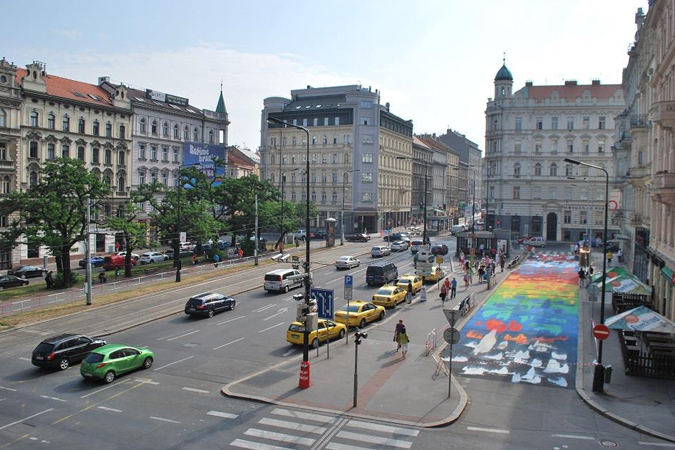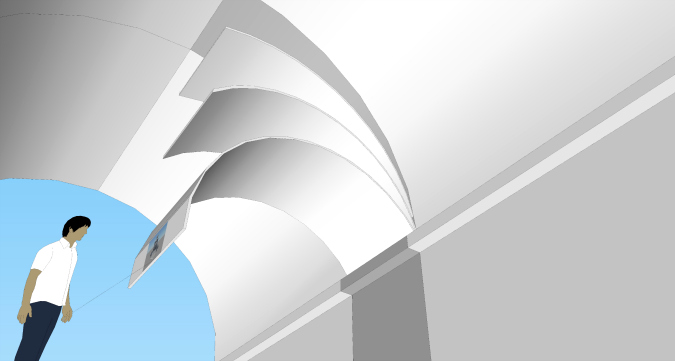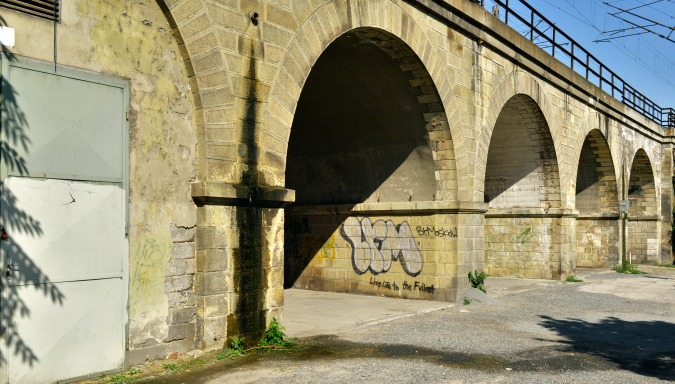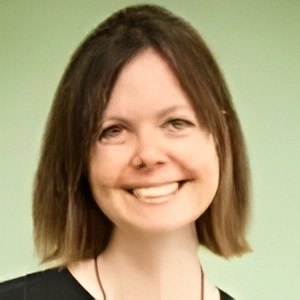Paris has Le Viaduc des Arts, one and a half kilometers of 64 vaults on the Avenue Daumesnil. Originally supporting the rail line Paris – Bastille – Varenne, the viaduct now supports fifty craft workers from furniture restorers to jewelry designers. Vienna meanwhile has converted the Gürtel viaduct into a thriving area for nightlife – filled with bars and clubs that offer both live bands and DJs. Prague’s most well-known (if we can call it that) viaduct cuts through the city’s Karlín district and is home to a parking lot. Prague 8 has been talking about revitalizing the viaduct for about five years now, and the team at the Centre for Central European Architecture (CCEA) has a plan to highlight the viaduct’s potential.
“The project’s idea is to show that change is possible,” said Yvette Vašourková, co-partner of CCEA and coordinator of Line Galleries. “We want to open the topic through Line Galleries to show it is important that the viaduct not only work as an historic monument but as potential for the city.”
Line Galleries will see a section of the viaduct between Křížíkova and Sokolovská Streets transformed into a cultural hotspot from September 19-21. Ten galleries will be creating site-specific work to present, one arch will become a bar, the CCEA team has invited dancers, musicians, and more to present performances, plus there are plans for a culinary demonstration and children’s workshops. Vašourková says they will utilize 15 arches, but the potential of the entire viaduct actually offers more space than the MY Národní shopping center.

A similar CCEA event took place at I.P.Pavlova / Lukas Cetera / www.peek-a-boo.cz
“When you do a renovation of this type of project – with a specific, special structure – we want to show you could leave space for shops but also connect it to culture,” Vašourková said. “This is a public structure we can work with and something that supports the culture of Prague.”
Two of the presenting galleries are Drdova Gallery and Center for Contemporary Art Futura, who is actually located in the viaduct’s neighborhood. Representatives from both galleries believe this type of public arts event is important.
“Public space has its positives and negatives. Art in a public space of course has a wider reach then art in galleries. However people often just pass it without really paying attention to the art,” said Michal Novotný, director of the Center for Contemporary Art Futura. “Festivals like this one devoted to the Karlín viaduct provide a space for art to be noticed, and it points out the importance and impact of places like the viaduct that many people pass by without thinking about.”

Vaclav Kopecky & Jan Pfeiffer plan a site-specific installation / Drdova Gallery
Futura is cooperating with Italian curator Valerio Del Baglivo who has designed a three-day event-focused program that will include, among other things, Del Baglivo screening art videos while serving spaghetti. Drdova Gallery meanwhile plans to present a site specific project by Václav Kopecký and Jan Pfeiffer. Lucie Drdova, director and owner of the gallery, said Pfeiffer’s work is based on his effort to generalize everyday situations and the way they are experienced; while Kopecký focuses on the medium of photography and its ability to make a record of reality and preserve it.
“Hopefully this project will be well-received and it can be a starting point for similar events underneath the arches of the bridge,” Drdova said. “I also hope it can bring more attention to contemporary art in general.”
Possibilities for the viaduct are the second part of the weekend. A three-day architectural workshop will be held in conjunction with the Architectural Institute in Prague (ARCHIP). Workshop participants will consider the future potential of the viaduct and present their findings on September 21.

From September 19-21 the Karlín viaduct comes alive
“The goal of the workshop is to see the future of the viaduct itself, how you can make it alive, they will be looking at the whole viaduct,” Vašourková said. “Our overall goal is to convince the city the viaduct is not an obstacle, but there’s big potential, it could be a new gateway to Prague 8, or to Prague 1, this is important to demonstrate.”
Vašourková believes if Line Galleries is successful it could be repeated annually until the actual renovations of the viaduct begin.
“The main aim of this is to show the potential of the site – we are architects and it’s always about the space,” she said. “The other is to activate the space with the galleries, performers. We could think about getting rid of the parking and creating a useful public space – you could have trees, clean it up, put in a few benches and it can be attractive. The project should open more discussion topics and we can support the idea of improving the quality of the public space.”
Line Galleries
Karlín viaduct
September 19-21, 2013












 Reading time: 4 minutes
Reading time: 4 minutes 




















